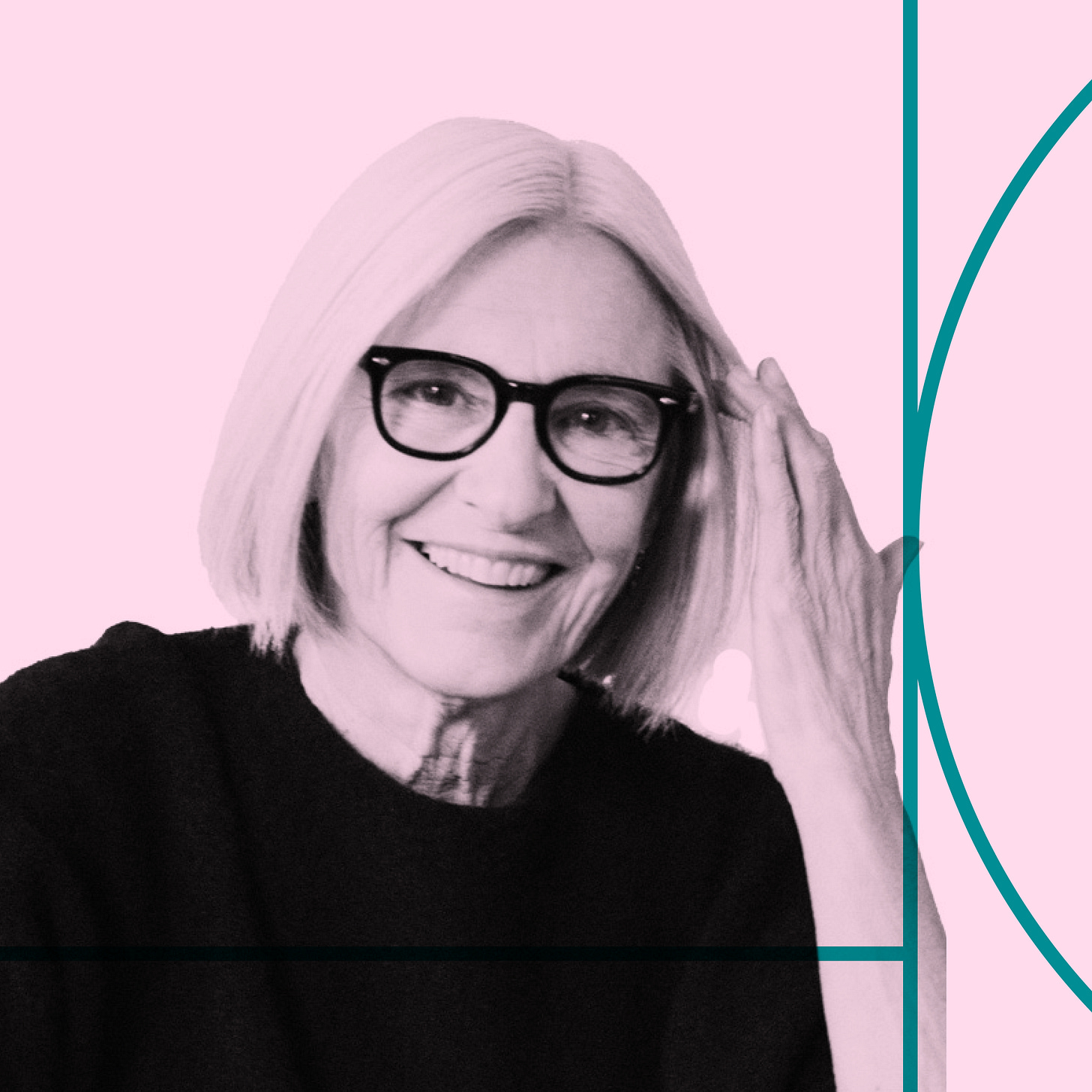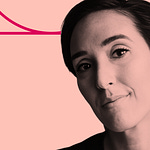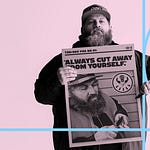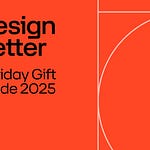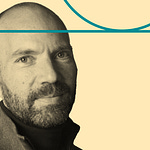Hi Folks-
We hope that everyone is enjoying their summer so far. We’re taking a few weeks off to be with our families, and to prepare for an exciting announcement that we plan to share soon. In the meantime, we’re rewinding to one of our favorite episodes with Eileen Fisher, founder of her eponymous fashion brand Eileen Fisher, Inc. Enjoy the episode, and we’ll see you in a few weeks.
We’d also like to give a huge thank you and shout-out to our sponsors so far this season. Please help us continue to bring you great guests by visiting the links below:
Fable: Build inclusive products: https://makeitfable.com/designbetter/
Methodical Coffee: Roasted, blended, brewed, served and perfected by verified coffee nerds 🤓 : https://methodicalcoffee.com/ (use code "designbetter" for 10% off of your order).
Freehand by InVision: The intelligent whiteboard that's half the price of Miro and Mural: https://freehandapp.com/
Cruise: Cruise is a team of researchers and designers creating a self-driving transportation service for the people and cities we love. Visit design.getcruise.com to learn more about how you can help design the future of transportation!
In his book The Laws of Simplicity, John Maeda says that “simplicity is about subtracting the obvious, and adding the meaningful.” Our final guest this season, Eileen Fisher, is a master at making the simple, meaningful.
Eileen is the founder of her eponymous and iconic fashion brand Eileen Fisher, Inc., which is known for its ethical & sustainable practices, and elegant yet simple clothing. She started the company in 1984, and grew it from her first sale of $3000, to annual revenue of over $300 million.
We speak with Eileen about her design principles, how she thinks about form, function, and sustainability, and how systems thinking has helped her develop a brand that stands the test of time.
We’re so glad you joined us for the sixth season of our show, and hope you were inspired along the way. Stay tuned for the next season, and in the meantime, we’ll be sharing some of our best episodes from past seasons, in case you missed them. Thanks for listening.
Bio
Eileen Fisher founded her women's fashion brand in 1984, with $350 of startup money. It's since grown into a company with over 1200 employees and hundreds of millions of dollars a year in revenue.
The company focuses on producing simple, timeless clothing, with sustainability initiatives including selling used pieces in excellent condition, resold through their Renew take-back program, as well as a Waste No More program which transforms damaged clothes into a new felted fabric, used to create wall hangings, pillows, and other accessories.
Summary (via ChatGPT 🤖)
In season six of the Design Better Podcast, guests discuss creativity in large teams, tackling seemingly impossible problems, and the value of interdisciplinary collaboration. Eileen Fisher, founder of the ethical and sustainable fashion brand Eileen Fisher Inc., shares her design principles, which focus on simplicity, timelessness, and systems thinking. By maintaining a consistent approach to shapes, fabrics, and colors, the brand has achieved lasting relevance and appeal.
Highlights
👩🎨 Eileen Fisher, founder of Eileen Fisher Inc., discusses her design principles and approach.
🕰️ Fisher's design philosophy emphasizes timelessness and simplicity, inspired by Japanese aesthetics.
🔨 Eileen Fisher Inc. focuses on shapes, fabrics, and colors to create a consistent and versatile wardrobe system.
♻️ The brand operates a "Renew" program, taking back and recycling used clothes from customers.
📝 Fisher is currently working on defining a blueprint for her design concept to guide future designers.
Transcript
Eileen Fisher (00:01):
We want to be transparent. We want people included in the sort of imperfect mess of what we're trying to do and that we're in process. And, you know, we want to help them understand what our big goals are
Voiceover (00:16):
In season six of the design better podcast. We're looking to the stars and beyond to learn how creativity thrives in large teams confronting seemingly impossible problems. The work we do as designers and leaders can certainly be informed by the successes of the best and brightest in our field, but big insights that reframe our approach to our work often come from adjacent disciplines. We can also learn how to become better collaborators by expanding our horizons beyond the design team, our conversations with Sarah Seager, professor of planetary science at MIT who researches exoplanets that might Harbor life and Chris Kemp, CEO, and founder of Astro accompany, turning space into a creative technology platform surface a cross-disciplinary approach, doing complex work with diverse teams. This podcast is hosted by Aarron Walter and Eli Woolery is brought to you by envision the digital product design platform used to make the world's best customer experiences discover more best practices, research, and resources for free at design, better.com and inside design.com.
Eli Woolery (01:24):
In his book, the laws of simplicity, John Maya says that simplicity is about subtracting the obvious and adding the meaning. Our final guests this season, Eileen Fisher is a master at making the simple meaning.
Aarron Walter (01:37):
Eileen is the founder of autonomous and iconic fashion brands, Eileen Fisher, Inc, which is known for its ethical and sustainable practices and elegant yet simple clothing. She started the company in 1984 and grew it from her first sale of $3,000 to annual revenue of over 300 million. Not bad.
Eli Woolery (01:58):
We chat with Eileen about her design principles, how she thinks about forum function and sustainability and how systems thinking has helped her develop a brand that stands the test of time.
Aarron Walter (02:08):
We're so glad you joined us for the sixth season of our show, and we hope that you were inspired along the way, stay tuned for the next season. And in the meantime, we're going to be sharing some of our best episodes from past seasons, just in case you missed them. Thank you for listening,
(02:30):
Eileen Fisher. Thank you for joining us on the design better podcast.
Eileen Fisher (02:34):
Oh my pleasure, Aaron. Nice to be here.
Aarron Walter (02:37):
There are lots of things we want to talk to you about today. Your perspective on design we think is particularly unique, especially in the fashion world. Many of our listeners come from a digital design background, though. Lots of different types of designers listen to the show and we find it tremendously valuable to talk to people who are maybe in adjacent spaces to hear how they solve problems to start us off. Curious if you could talk to us going back to those early days, as you were starting to form your vision as a designer. So that would be like in the early to mid eighties, where you had a clear perspective emerging about fashion and how you want it to dress, how you saw your customer, you know, potential customer addressing. Could you talk to us a little bit about that vision that you had?
Eileen Fisher (03:26):
Yeah, I didn't actually study fashion design. I come out of interior design and graphic design. So I kinda think I come with a different mentality. I think about what lasts, for example, like timelessness enduring design. And I was first inspired to actually create this concept when I was in Japan and I was inspired by the que mono and just in general, the simple and natural kind of aesthetic of Japan, but in particular, the key mono. And I love the idea that one shape was the main shape that everyone wore for like over a thousand years in Japan. And so I was inspired by that idea that you could create something that would last than a shape would kind of define the design. And when I grew up, I, I did so with my mom and my mother was very much about saving every scrap of fabric and making these simple little shift dresses and things back in the fifties and sixties and that kind of thing.
(04:31):
And I wore a uniform in grade school in high school when I found myself in New York, I remember feeling like whoa, it had been so easy to get dressed when I was young, even though I didn't like the uniform, I liked the idea that it was simple, get up in the morning and put it on and go, you know, you don't have to think so much. So I wanted to create something that worked like that, but that wasn't kind of just quite so Moring that had some options and Ellen different elements. And so I started kind of thinking of it as a system, as a kind of kit of parts or like different puzzle pieces that could work together in different ways. In the beginning, it became very much about finding the right fabric. What are the ingredients or the elements of this design concept? So shapes were a key piece and I kind of always saw pictures of shapes, simple little wide leg pants. You know, I still make them today, little kind of box tops, simple, easy kind of shapes. So it was combination of shape fabric, which was, you know, kind of the, the product itself had to be made out of material fabric. So the fabric was a critical piece and of course color and then, you know, texture and how it comes together and how the pieces work.
Aarron Walter (05:51):
It's a very graphic designer perspective. For example, like Milton glacier has this principle style is not to be trusted. Versus if we looked at fashion design philosophy is typically like there's a different season, there's a different theme. And that shifts pretty dramatically. You'd see some sort of like similarity across different seasons, but it does shift style quite a bit versus your philosophy, which is very much about timeless systems,
Eileen Fisher (06:21):
Right? It's interesting because in the clothing business, you do have seasons because you want to wear clothes that belong to the seasonal conditions. So in the summer you just feel like wearing linen or cotton, cause it reason it's cool. And in the winter you want to be cozy or a warmer anywhere, wools and Kashmir maybe, or you know, that kind of thing. So you do want to respond to the season, but you don't want to be stuck in the trends of the moment, you know, and at the same time you want to be relevant to the times, you know, so we have sort of library of shapes, you know, that we work with and that we shift from year to year, we feature different things or lean into things that maybe belong to the trend in a certain kind of way, like proportion a little bit or something like that or color, it might makes us feel relevant or life we belong.
(07:21):
But I think what's really surprising is how it lasts over time. And I'm even surprised by it because we have this program. I'm not sure if you're familiar, we call renew, which is we take our clothes back from our customers and we recycle them. We resell them. And what I find is I was terrified when we first started this program 15 years ago that I was going to like, oh my God, Hey, everything. And remember all the mistakes and all of that. And even just today, we're pulling out still things from our renew program and oh, look at this and right, let's do that one again. And it's still relevant. And you know, we find young people wanting to shop our vintage clothes. And that's really interesting to me and that they're relevant in the parts still fit with the new pieces going forward.
Eli Woolery (08:08):
I think this will probably resonate with a lot of our audience who are product designers who think about design systems a lot and reasonable components. And how within these systems do you think about still creating a brand feels so that it's not just generic components, but people that identify it as Eileen Fisher?
Eileen Fisher (08:25):
Right. Well, I think important aspects that are Eileen Fisher, I guess are just simplicity, comfort, ease movement. There's a certain fluidity about these clothes, a certain idea that one should move and eat and dance and all those kinds of thing in our clothes. And so, because they're so simple, they dress up or dress down. And I think women really like that they can wear a simple dress and wear to work or 2 million go out or not take it off when they come home and grab their kids and sit on the floor and throw in the washing machine. So, you know, the clothes have that kind of versatility. I think that's important. So we have our sort of principles and ideas of how we design and what kinds of pieces fit or don't fit. The other thing is we don't do a lot of patterns or prints.
(09:19):
You know, we have done stripes and we have done prince over the years and it's not that we don't do them, but it's minimal in the way we do them. And you do a lot of, you know, pretty solid colors just, and we do color though. We do with this season in particular, I think with COVID we got really inspired about color and you know, did some fun yellows and greens and things like that, which maybe would have been brighter than we have done in the past. So we are definitely inspired by the time. So we definitely have our own aesthetic. I'm always surprised when people say, oh my God, it's been the same for so long. I like to me, I see all the differences, you know, because I'm so close to it. But from the outside, I think people see it's simple, it's comfortable, it's versatile and moves. And it's a lot of people and things like that.
Aarron Walter (10:06):
And design, especially in video game design, there's a concept of an open system versus a closed system. A closed system would be like Mario brothers, super Mario brothers, where you can only like go forward and an open system might be like, I'm dating myself. Cause I don't play video games, but like the Sims where you, you just like wander around a world and discover what's happening. And it seems like the way that you think about design is very different from other fashion designers in that you've got an open system, whereas a lot of designers will have a really great piece. Maybe it's very iconic and has a fantastic print, but that print kind of doesn't have a lot of versatility. What do you pair with that? It's very limiting. And so then when you go to pack your suitcase, your suitcase is huge because you want to wear that cool shirt, but it requires that one pair of pants. And then the next day and the next day, and you don't have that versatility of an open system. Do you think about that? Like the ability for other pieces to fit into your line into that design system that you're designing an open system instead of a closed system?
Eileen Fisher (11:16):
It's interesting. I it's like a different language. You know, I, I guess I don't really talk to people outside of my industry too often. So I I'm intrigued by that idea. Open system, closed system. I think that idea I'm stuck now on the packing and traveling because we're kind of also known for that too, that our clothes are so great for travel because, you know, because of the way they pack and that's not the point, but the point is what you're talking about, systems and the way they work and work together. And when we add pieces, it's kind of like we're putting a few more pieces into the puzzle. It, the possible ways you can wear your clothes just by adding a few more pieces. Part of what we do actually is we work with a consistent sort of, maybe this is a closed system.
(12:03):
It's not totally close, like a consistent system of fabrics. You know, we're pretty focused on, you know, sustainable materials and we like our customers to get to know and be really familiar and comfortable with our fabrics. And so then we change colors or have different shapes. So we play within a system of fabrics and I think that's what helps one to sort of build a wardrobe that, you know, this consistent shapes and fabrics. And I don't know if I answered your question about oh, system or closest because it's a little bit of a new language for me, but I like thinking about it like that. What I'm working on actually right now is to define sort of the blueprint of what this system is because, well, I'm 71 years old and I've been doing this a long time. And so I strangely still love it.
(12:52):
I picture that it's going to need, you know, to go on without me. And there have been phases where I've been less close to the design where I've been a little unhappy, it kind of got a little out of the pattern of what I think the design concept is. And so I've been trying to kind of land that blueprint and kind of really define how to design within this concept so that new designers coming in can follow. But also there's, it's a very, in a way open system, there's a lot of derivatives of the shapes and proportions, a lot of different ways to change the neck line or add a sleeve or lengthen or narrow or shorten there's many ways to just, you know, work within the concept and lots of options to be creative, but to stay within the frame or the fence. So to speak. I have to define that a little more clearly. That's what I'm really working on right now. So
Aarron Walter (13:49):
The document that like, what are the mechanics of actually documenting that? So everyone can access that.
Eileen Fisher (13:56):
Well, I'm struggling with that, but I have a great partner he's helping me do this. He's our internal. Now he's working our sort of chief creative officer and he's helping me to actually lay out the way of thinking about shape, the way of thinking about fabric, the way of thinking about color and the way of thinking about how to wear, how to put it together, he's redesigning our website, things like that. So that kind of can come to understand the system approach and find your wardrobe within it. And all of that. We're actually thinking of it as our conscious closet. How do we plan? How do we think, how do we add pieces that help each customer to build her wardrobe? But he's helping with the blueprint concept and a couple of have another designer who's been with me for 25 years and she's also helping in that process. Cause I tried to do it myself and get kind of overwhelmed, you know? So I think the reason I need a system is because I struggled to organize myself. I always say that I need comfortable clothes. Cause I'm sort of uncomfortable. Then I need to organize system of clothes because my class is kind of a mess. So I always tried to organize my life, you know, so I kind of come out of what I need. Others must also solving the problem.
Eli Woolery (15:17):
I earlier you touched on design principles and we're curious how you arrived at your own design principles and imagine your time in Japan and the simplicity of the design. There played a part in that.
Eileen Fisher (15:28):
I also have worked with a couple of pretty talented designers when I was younger. That was really interesting. And you probably don't know with them, Earl Ferguson was a architect and designer that actually designed my offices. He designed my home, but I worked in when I was 22 years old and I learned a lot from him and he was just a great designer. You know, he didn't do lots of, you know, huge projects or anything, just a great design thinker. And I learned a lot from him. I learned a lot from Ray OSHA, Mora graphic designer. I've worked with also, he was my personal partner too. That's how I ended up in Japan. So both of them were really talented designers. And so I learned from them and I think some of it is intuitive to, you know, I followed my own instincts and the at one thing about clothing that is different, I think like I'm thinking back to graphics and interior says like clothing is very feeling oriented, you know?
(16:28):
So I often find myself talking about form function from, you know, sort of design principles, but I also talk about feeling and that's the kind of softer side of clothing it's like, so there's always kind of this emotional reaction like, oh, how does it fabric make me feel about like, how do I respond when I see that thing or touch that thing ergonomics. And all of that was an important part of interior design graphics. Didn't quite have that emotional response, like when something snaps together and you know, you'd have the right thing and you have an emotional response to it, but I'm always, I'm always thinking about that. You know, it's like, I'm like, can I dance in this garment? Does it have the right feeling for me? You know, so, you know, and that's something, that's the magic piece. That's a little bit hard to fit perfectly in the system sometimes. You know? So there's always that kind of little surprise element that you have to kind of wait for or be open to the mantic piece. I don't know how that works with tech design, but I'm sure it's there too, because it's always imagined to me how it even works, you know?
Aarron Walter (17:33):
Ultimately we're all designing for an emotional experience at some point. Yeah. I'm curious. Have you figured out how that would be documented for those who come after you like that instinct the feel that you have of like, are
Eli Woolery (17:49):
There some guiding principles
Eileen Fisher (17:50):
There? Well, I am making a note about that because I don't think we have that in the document yet. I think that's really interesting because I just came out of a meeting. We were talking about color for next fall and I could just feel certain people responding to certain colors and you know, where the energy was. And I think it's really important that intuition actually, I had somebody who worked for me years ago, who did a project on intuition and we didn't really go anywhere with it, but you're reminding me that that's a really important piece to document it, to have people learn, to tune in to how did they feel when they saw that, which garments, you know, gave them that reaction and what happened when they put it on. Sometimes you look at something and then you don't get the reaction and then, you know, you put it on and go like, whoa, this feels different than I thought it was going to feel.
(18:43):
Now, now I get it what you're trying to do. So it's sort of that combination, you know, of like, what's that feeling when I just look at them when I see a color, when I see something, so that there's that. And then there's that what happens when I actually put it on my body and touch it and sensitive, you know, feel it. And then like I think about customers and that everyone's different. So what happens when they go into the dressing room and try things on, you're always trying to get people into the dressing, which is trying it, see what things, you know, the response is different because people are different. Some things don't work on some people and they don't, it doesn't feel right. You know, sometimes the great things just tend to work on, have almost everyone, I don't know what that is. Some kind of magic, but people are different body types, different needs, different feeling, different everything. So that's the hard thing about designing clothes too. It's really designing to be inclusive for everyone to consider different body types, to consider different color times different lifestyle needs. It's daunting at times. So just I had to do it to can do and try not to get overwhelmed. So what I try to say, don't always succeed.
Eli Woolery (19:56):
So I think there's this emotional component to the design of your clothing. And then there's the form and the function. And it sounds like being inclusive and being sustainable. Those are also important goals. How do you go about balancing all these goals? Which might be a tension sometimes?
Eileen Fisher (20:11):
Yeah. Sustainability has been a huge one lately that we really struggled with because we keep working to go deeper and you know, sometimes we have real emotional response to something that's actually not the most sustainable of materials. That's something I'm struggling a lot with right now, the relationship between those things and you know, where are we draw the line? And the lines are not totally solid yet. You know, just like absolutely not certain materials. Yes, absolutely not to certain materials, but then other things there's a little more gray. Like for example, we've all of our cottons are organic. We just decided we're not doing anymore conventional cotton or all of our linens are organic where it gets a little more difficult is in some of the other areas like we used viscose rayon and this goes for years. And then we found out that ran we knew it kind of came from Woodhall.
(21:16):
We know it's biodegradable, which is important. I'm a big believer in natural fibers. But then we found out that we couldn't trace the ran and it might be coming from the rain forest. And so they might be actually tearing down a rainforest to make this go. So we decided we were going to phase it out of our clothing and it's been a long and difficult process, but we have almost switched everything over. I think we still haven't fabric looking left that we're struggling with, but almost switched everything over to 10 cell. And that's an amazing kind of reinvention of ran all of the wood pulp. They use traceable and they use a closed loop technology. They clean the water as they go. It's really amazing. And then of course it's biodegradable and mix lovely, lovely drapey fabric. And so we're really using a lot of it and it's selling well.
(22:08):
So we're happy. It was a difficult transition, but it's served us well. So we just keep looking for new things like that and trying to solve some of the other issues. Well, for example, there's issues with wall and, you know, we are moving towards regenerative walls, which is really, really exciting because you can actually like with 10 cells clean the water as you go, but you can actually regenerate a land while you're making wool, you know, raising sheep, then the way they do it, they actually regenerate the land. So we can actually have a positive impact by using wool, which in some cases yet, you know, there's a lot of not good about using wool. So it's a wonderful biodegradable breathable fabric. I love it.
Eli Woolery (22:57):
Hi everyone. Hope you're learning as much as we did from our guests, Eileen Fisher, during the interview, Eileen mentioned the importance of including people in the imperfect newness of a project. And we want to take a minute to share a product that can help you bring teams together early in the process for visual collaboration envisions online whiteboard freehand. Do you run brainstorm with your team? How about retros or planning meetings? If so you probably benefit from an online whiteboard it's truly made for everyone. The magic of free hand is that it's an inclusive, welcoming space for your whole company. Yep. You and your friends in HR or marketing will feel comfortable getting involved. We designed it to feel familiar the first time you tried it with funds, sticky notes, templates and emoji reactions, but also flexible enough to evolve into more complex projects, but diagrams and presentations. We love to use it for wireframing brainstorming, sharing ideas, getting feedback, even to plan out our next episodes of this podcast, possibilities are endless. So if your company is looking for an online whiteboard that anyone can use, check it out for free at www dot envision, app.com/free hands. Thanks so much for listening. And now let's get back to the show.
Aarron Walter (24:16):
One thing that's really fascinating to us is how clearly you and the whole company have articulated your design principles and mission and vision. And you've even taken the extra steps of publishing that for your customers to see this is what is important to us. One of those principles you've been speaking to indirectly is circles over lines. I wonder if you could talk to us about your principles and why it's important to make those public to everybody?
Eileen Fisher (24:48):
Well, we want to be transparent. We want people included in the sort of imperfectness of what we're trying to do and that we're in process. And you know, we want to help them understand what we're trying to do and what our big goals are. Like, we really want to be a circular company. We want to take responsibility for all the materials that we use, all the products we put out there, all the dye process and all the things involved in it. And it is incredibly complex. And so, you know, we work at it every day and just try to keep getting better. And we include our customers in like trying to tell them what we're doing and inviting them to bring their clothes back and be a part of the circle. And you know, the clothes we can't resell, whereas starting to remake into other products, you know, small bags, they can purchase them online, you know, out a few things like that.
(25:41):
We're just starting to really build into the circular idea. We even dream of like telling all the ingredients on our clothes and all the places everything has been, and we're just getting ready to do more of that kind of thing. So we just want everyone to be included because it's a really complex story and we need everyone's support to keep making it better. And we also want to share with other companies, you know, because we feel like, you know, we could meet our goal of being a fully circular company, which will take us of course years. But even if we do, if we don't help other companies to get there, we're not going to solve the climate crisis. We're not gonna be helpful enough by just getting ourselves where we want to be. So the more we let other people know what we're trying to do, the more other brands are interested and trying to sh share what we're trying to do with them. Then with us, those kinds of things, we build more, a better future. And that's really a bigger goal. Do
Aarron Walter (26:43):
You ever compare notes with [inaudible] and the Patagonia team?
Eileen Fisher (26:47):
Yes. Yes. Yes. We have our teams very connected. Yvonne. I've spoken with a few times rose Macario. I was talking to a once a week during COVID. She really helped me through the crisis. She was the CEO there for 12 years. We are very connected behind the scenes. Lots of our team, our sustainability teams and design teams are connected to their teams. We're involved in lots of different organizations trying to move the industry forward. And it's a lot. We need a lot of investment. We need a lot of awareness. We need customers to be more and more aware of the industry, you know, make better and more conscious choices. It didn't even touch the workers and all those issues. There's a lot, there's a lot, but there's a lot we can do. There's a lot of possibilities and to design, we can make the world better. It's kind of amazing to me.
Eli Woolery (27:39):
I mean, I teach a product design class where the students come up with product ideas and occasionally they'll actually start companies around them. And one that came out this past year, actually maybe a year and a half ago now was a fashion company that uses dead stock the material, unused to create clothing there, then companies names oddly, and what I've noticed over the past eight years teaching as that students are more and more interested in the kind of social impact of the companies that they are going to start or join. And have you found that you've been able to kind of use this in some ways as a recruiting tool? Like since you're so focused on this, it's, it's helped you get young designers and other employees interested and engaged with the,
Eileen Fisher (28:17):
I think it's really important. I think that people want to be engaged in meaningful work, even clothing designers, fashion designers, so to speak. They want to feel that their work matters and everyone's aware of the climate crisis and the issues, human rights issues and the supply chains. And everyone wants to participate in the companies that are trying to make a difference. And we want to feel that our lives matter and you know, we're not just making stuff and selling stuff and all that. So I think that that makes for better, easier recruiting people wanting to work here and people staying. We have many long time employees it's important, meaningful work.
Aarron Walter (29:00):
Speaking of your employees, I think at this point you've got roughly 1200 employees.
Eileen Fisher (29:05):
Well after COVID we have only about 800 now that was a serious downsizing. We went through. It was a very difficult time for us. They're painful, you know, I mean, we were closed for three months. All of our stores department stores canceled three months worth of orders. Everything stopped in our supply chain. We were worried about our organic farmers. We were just trying to pay the bills and survive through it. And so it wasn't really heartbreaking moment for us. And, you know, we went to several rounds of layoffs, which is also the worst way to do it, but we never expected COVID to go on as long as it did. And there were a silver linings in the midst of it, all we from me, it felt like a chance to rethink and really come back to the center of the design process and really, you know, work hard on this blueprint and really make sure, you know, we were going to land the philosophy and be able to move it forward for more generations. That was a good thing. In the end,
Aarron Walter (30:10):
The early days it was you, right? I mean, you, you were the designer, the visionary, the person who was sort of like setting the standard of here's, what we're going to make, defining the principles and so forth. And you went through what I can only presume would be very difficult to grow a company where you have total control over the creative process too slowly, paying that out to other people. And I would assume at some points, other people, even though you've vetted them, well worked alongside them very closely. They have their own perspectives that sometimes will deviate from yours. Could you talk to us about how you navigated that challenge of letting go of the creative process and how you remain creatively inspired and, you know, still seen as, as a leader, through those transitions
Eileen Fisher (31:01):
For many years, the thing worked pretty organically, I think because I've been at the center of it for the first 15 years or so. And then there were so many people there in the middle that stayed for so long. And so a lot of things just kind of built out from there. So then that sort of happened naturally. I think it got particularly hard about four or five years ago when a lot of the original team began to retire, no, and move on and trying to hire a new people in without this blueprint or without enough articulation of what the idea was. I feel like we went off track and there were lots of things that weren't feeling like they belong. So I think that I would say that we didn't have a great structure or process in place because it had happened so organically and it had come through the people.
(31:58):
And so I think that's another piece of what I've been working really hard on the last year is reorganizing the teams and, you know, really looking at all the designers and all the talent and really trying to understand everyone's gifts and help create a better structure and processes, not my gift. I'm going to design and tell you that'll work that won't work or, you know, make it more like this or like that. But when it comes to figuring out the processes, I really need a lot of help. And so I have a few people right now, a couple of people in particular are really helping me to reorganize the teams and redefine roles and recreate the structure. And of course, as I said, you know, the land, the blueprint of the philosophy. So I would say it's still very much in process, but I'm going to say we're halfway there. No, that doesn't mean that's actually. So, because I don't think whatever gets there, you know,
Eli Woolery (32:58):
So I think over the years you've maintained control of your business and I believe 40% of the company is employee owned at this point. And I'm sure you've had many offers over the years to sell or to merge. Why have you done that? And how has that kind of affected the way that you think about the business and design, if you're proud of,
Eileen Fisher (33:15):
Yeah, I never wanted to sell, it was never really about just making a lot of money. I, I think it was too much a part of me or something like that or too much my vision that I don't know, I just wasn't interested in selling it. I think a lot of people start companies with the intention of building it and selling it. But I, I never thought about it like that. I just want it to serve the women that were my customers. And I just wanted to make clothes that I loved and that they would love and that would work for their lives and make things a little simpler. So I didn't really figure out what I wanted to do with the business. And honestly, I still trying to figure that out so I can remember when it was that I sold 40% to the employees.
(33:59):
So it wasn't really interesting idea. And I think it came through my CFO at the time because he felt I should diversify. And I also had already been doing profit sharing for the employees. So I really want people to feel like owners be owners. You know, they participate in the upside and the downside. And we've had years that have been more down like this past year, though, many signs of hope right now. So things are better on the upward swing, but I don't like this idea that the rich get richer and the poor get poorer. And the 1% are the only ones who make all the money. It just feels wrong to me. So I liked I'm a little more democratic in the way I like the company to run. So that's what we did. We shared 40% of the stock. So now I'm in a dilemma of what to do, you know, at my age, what happens, you know?
(34:48):
And I've been a little bit fascinated by the thing that Paul Newman did with the charity. And that's an idea, you know, I don't know my daughter's graduated in architecture. I don't know what she's thinking, but she wants to work in architecture. So she's not going to take over this company right now. But I think that somehow, maybe it belongs back to the employees or to some combination of foundation and employees. And right now in the midst of really trying to responsibly think of how to take the next steps and you know, what happens to the company because I obviously won't live forever, you know?
Aarron Walter (35:27):
Yeah. You maintain from an outsider's view, this magical, useful curiosity about design, about your work. You retain a passion for what you're doing. And for a lot of entrepreneurs, founders, or designers who did not found the company or run the company, there is a certain point where the business can kind of suck the spark out of the work, right. Could you talk to us about your personal journey and how you keep that youthful curiosity?
Eileen Fisher (36:01):
I'm fascinated by learning. I'm a, like a seeker and a learner and it just fascinates me. I just keep seeing this organization as a way for me to learn for others to learn and whether it's about clothing and how to make it better and how to do that. Or I have so many personal lessons I learned through my work and to connecting with people and struggled to communicate and, you know, learning to speak up and to say what I want, it's been Vicky or of that, you know, like, oh, what is this philosophy? How do I articulate that? So I guess I'm just driven by learning. I'm curious. And I it's like I wake up in the morning and like, oh my, what am I going to learn today? What's going to happen? You know, what, what happens next? So it's just that I think design is like that.
(36:54):
It's just like, you've designed some things that are just great and they just are, and that's great, but there's always, you know, evolution and something else happening and new materials to work with and those kinds of things. But I do know that, you know, my days as leading the design work are somewhat numbered, so I don't know what that exactly means, but I think it, I think it is, and sometimes not to be brand, but sometimes I think it's like Bauhaus design or something. It's a concept. And we'll, if I set it up, right, it will live without me, you know, and it doesn't have to be exactly how I would do it. But in principle, I think it can go on
Eli Woolery (37:39):
Erin and I are curious, I'm kind of a t-shirt and jeans kind of guy. I'm a surfer. So fashion isn't always top of my mind, but would you, would you ever consider making that's right. Would you ever consider making a men's line of clothing or have you ever experimented with
Eileen Fisher (37:54):
We've experimented a little bit in my lifetime or in my rain, so to speak? Probably not. Even though one day, I think we should. And I think someone will, and I think we definitely should have men's line men sometimes, where are some of them are very, you know, kind of unisex, you know, and they're very simple lines and we did try a little bit and weren't successful and I think we just didn't set it up. Right. So I think it would require, I think it's belongs in the next phase. It's funny because from the very first story I opened, people came flooding in women with their husbands men walking and saying, oh, why don't you make men's clothes? And I used to say, I can't, I planned to do that in year or two. And you know, how many years later, 36, 7 years later, we don't have men's line. So I don't know, maybe it's still working in service of women. You know, our bodies are somehow different and we've always not, we've not had enough of a system. I think men's wear is sort of, is a little bit more of a system. And so it's a bit similar, so maybe I'd want it to give women some of the advantage that I think men have in the way they dress simply.
Aarron Walter (39:02):
That's interesting. I, I feel like men's wear is sort of like it's so limited. It's such a box of what's possible and how things fit together and the whole light, whole idea to bring us back to a design systems like capsule wardrobes of like, here are the things that all fit into one space that you can pull together. You can take them on a trip and you can be prepared for whatever and feel your best, you know, back to the idea of designing for that emotional experience. It, people can just feel their best when you equip them with the right tools.
Eileen Fisher (39:38):
Exactly. No, I think that's exactly the goal. You try hard to do that. I was just thinking about men's wear, you know, cause when you were talking, it was reminding me of how I felt about my uniform as a kid. Like it was boring, you know, and a little too much of a tight box I was in, you know, and then it was easy and in some ways I envy men having it so easy, you know, but also it could be more creative. So someone really needs to take on that job of really doing something more fun for men. I remember standing in front of a group of 50 CEOs, all the man, except for, I think two or three women in the room, you know? So they were really top tier fortune 500 company, CEO executives, all of them and these pristine suits and ties. And I just thought, oh my God, I sat there and my comfortable, I don't remember it will suit or something like that. And I thought, I just looked at it and I couldn't say anything except for, with all my God, someone's got design, you guys some clothes, you know, I must be terribly uncomfortable with COVID. I think that maybe they'll give up the suits. It dies out. I don't know. I hope so.
Aarron Walter (40:49):
Eileen, what are you reading, watching, listening to that you're a passionate about or has gotten you excited lately?
Eileen Fisher (40:57):
Well, in reading a book, I Hedgie Fitzsimmons, it's called release and I'm in the process of decluttering my home and my life. And it sort of fits with my idea of conscious closet and being more and more radically simple. It's helping me. Yeah, they had, and I'm also reading a book by bell hooks on love. And of course there's no better topic than love and it's a beautiful book.
Aarron Walter (41:26):
Fantastic. Well, Eileen Fisher, thank you so much for your generosity and your time today.
Eileen Fisher (41:32):
It was fun talking with you guys.
Voiceover (41:37):
This episode was produced by Eli Woolery and Aaron Walter with engineering production support from Brian Pake of Pacific audio and brought to you by envision. If you found this episode useful, please leave us a review on apple podcasts, Google podcasts, or Spotify, or simply drop a link to the show and your team's slack channel. It'll help others discover the show. Want to learn more about building your career and design practice, visit design better.com and inside design.com where you'll find a library of free eBooks, audio books, videos, and articles about foundational concepts of design and business until next time.




